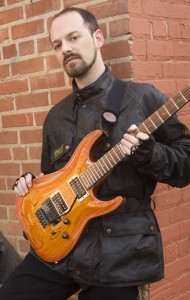Guitar Harmonics Finally Explained
 Guitar Harmonics are one of the trademark techniques of metal guitar, as shown by players such as Joe Satriani, Dimeba Darrel, and Van Halen. A properly executed harmonic will sound like your guitar is ”screaming” or squealing”.
Guitar Harmonics are one of the trademark techniques of metal guitar, as shown by players such as Joe Satriani, Dimeba Darrel, and Van Halen. A properly executed harmonic will sound like your guitar is ”screaming” or squealing”.
The technique for playing guitar harmonics is not terribly complicated per se, if you know what you are doing. The problem is that often we don’t know what we are doing, or we do not know it clearly enough to make the technique work reliably.
I discovered my lack of knowledge in this area in the worst possible way: while on stage. I had this dramatic solo spot in which the band suddenly stops, all the lights are on me, and I was supposed to hit a pinch harmonic to start the solo. The only problem, I completely botched it, looking like a fool in front of the audience.
Well, a failure is a failure only if we don’t learn from it, so I promised myself I would learn everything there is to learn in order to never miss a pinch harmonic anymore in my life. Surprisingly, it wasn’t as difficult as I thought it would be – it took only a couple of days (in time for the next show! ) I also learned more than what I set up for, specifically that there are many more available harmonics than I have seen used by other players.
What Is the Problem Then?
Most players that fail to perform an harmonic assume it’s because of a lack of technical skills, such as “I have not picked it strong enough”, or “my hand position is wrong”. But the actual technique, that consist in hitting the string with the pick and your right hand thumb at the sam time, is quite simple after all. If you were able to play a pinch harmonic just once, then you should be able to play it anytime without any problem.
The real but unacknowledged problem seems to be that pinch harmonics need to be played with the picking hand on specific positions of the string, and that few players take the time to learn them properly. Add to this the fact that the harmonic positions do change depending on the note you are fretting, and this explains why most people’s idea is to randomly try to play a pinch harmonic whenever the right hand happens to be, and hope for the best.
So, how professionals do it? I have never heard Zakk or Dimebag miss an harmonic, so there must be a solution, right? There must be a way to play the harmonics in a fail-safe way, without the uncertainty of just “going for it blindly”.
And the solution is: any professional player worth his money has actually spent some time to learn by heart all pinch harmonic positions. It may seem a humongous task, but if you actually try and do it, you will see that there is a reason in how the harmonic positions move with the note you are fretting. With a little training you will soon get a feeling on how to find them naturally — but you have to put some work in first. Let’s see how these positions move, and the technique used to play them.
What About Technique?
And now some practical suggestions on how to perform harmonics on your guitar:
Natural harmonics: your left hand finer will just touch the string, without actually fretting the note. Then your right hand will pick the note as usual. Your left hand should now let the string ring freely by moving away.
Tap Harmonics: they work like pinch harmonics, i.e. they have the same positions on the string, but rather than playing them with your pick and right hand thumb at the same time, you use one of your right hand fingers to ‘tap’ string against the fret of the guitar at the harmonic position.
Pinch (Artificial) Harmonics: Use preferentially the bride pickup (the neck pickup may not sense your harmonic) and make sure you are playing with distortion on. The whole secrets of the harmonic is in picking the string and simultaneously touching it with your right hand thumb on a harmonic position. To help with the sustain of the note, you can use some left hand vibrato that will “bow” the string on the fret.
Moving Positions
The basis of everything are the position of the natural harmonics, the ones you play on the open string. The lowest harmonic (the easier to play) are at the 12th, 7th, and 5th frets. These are not the only ones, tough: there are many more usable ones. For a complete map of all of them, have a look at the free eBook linked at the end of this article.
The positions of the artificial harmonics, the ones you play while fretting a note, derive directly from the positions of the natural harmonics. Whenever you play a note, you are “shortening” the string by a set number of frets. All the positions of the harmonics will “move up” by the same number of frets. As an example, let’s take the natural harmonic at the 12th fret. Now, If I play a note on the 4th frets, the harmonic position will move up from the 12th fret to the 12+4 = 16th fret. This position is perfect for a tap harmonic (see below) since it is still on the fretboard. If the harmonic moves outside of the fretboard, then you can play it as a pinch harmonic.
What Should I Do Now?
The next step is for you to sit down and learn the positions of natural and artificial harmonics as explained above. In order to help you, I have written and eBook that contains not only photos of the technique being played, but also a map in high resolution of ALL playable positions. And I’m giving this eBook out for free, how good is that? You can download here your free eBook ‘Harmonics on Guitar’.
About the Author
A professional prog rock musician, Tommaso Zillio is a regular writer of columns about Music Theory for Guitar.
Guitar Harmonics are one of the trademark techniques of metal guitar, as shown by players such as Joe Satriani, Dimeba Darrel, and Van Halen. A properly executed harmonic will sound like your guitar is ”screaming” or squealing”.
The technique for playing guitar harmonics is not terribly complicated per se, if you know what you are doing. The problem is that often we don’t know what we are doing, or we do not know it clearly enough to make the technique work reliably.
I discovered my lack of knowledge in this area in the worst possible way: while on stage. I had this dramatic solo spot in which the band suddenly stops, all the lights are on me, and I was supposed to hit a pinch harmonic to start the solo. The only problem, I completely botched it, looking like a fool in front of the audience.
Well, a failure is a failure only if we don’t learn from it, so I promised myself I would learn everything there is to learn in order to never miss a pinch harmonic anymore in my life. Surprisingly, it wasn’t as difficult as I thought it would be – it took only a couple of days (in time for the next show! ) I also learned more than what I set up for, specifically that there are many more available harmonics than I have seen used by other players.










